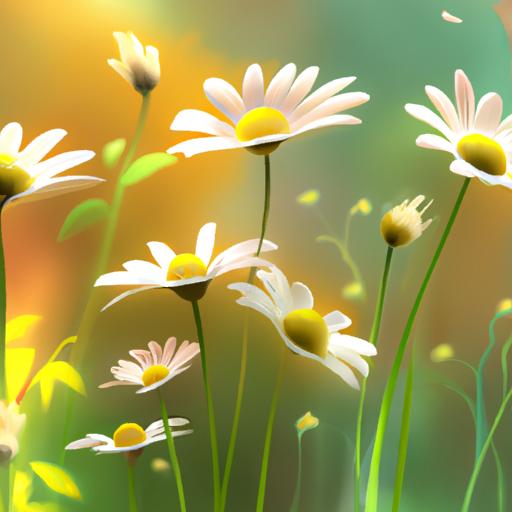Daisy flowers have been captivating people for centuries with their beauty and classic look.
But have you ever stopped to consider the individual parts that make up a daisy flower? In this comprehensive guide, we’ll take a closer look at each of the parts of a daisy flower, from the central disc florets to the receptacle and more.
We’ll also explore the importance of each part and how they all work together to create the perfect daisy.
So if you’ve ever wondered what makes up a daisy flower, read on to find out!
Table of Contents
Short Answer
A daisy flower consists of a yellow center disk, a ring of white or pink petals, and a green receptacle.
The center disk is made up of many tiny flowers called florets, while the petals are individual petals that form a ring around the center.
The receptacle is the stem upon which the petals and center disk are attached.
The petals and center disk together form a cup-like structure, giving the flower its signature daisy look.
What is a Daisy Flower?
A daisy flower is a type of flowering plant native to many parts of the world.
It has a recognizable shape, with a central disc of small flowers surrounded by a ring of larger petals.
The daisy has been a popular symbol and motif in art and literature since ancient times, associated with innocence and purity.
The daisy flower is composed of several distinct parts.
The most obvious are the small flowers in the center, known as disc florets.
These are surrounded by a ring of larger petals, called ray florets.
Both parts are essential for the daisy to function and reproduce.
Beneath the disc and ray florets is the receptacle, a cushion-like structure which holds the other parts of the flower.
The daisy also has a stem, which helps support the flower and carry nutrients and water to the other parts.
Below the disc and ray florets are leaves, which provide additional support and help protect the daisy from the elements.
Finally, at the base of the flower is a set of small leaflets known as sepals, which are essential for the daisy to flourish.
Each of these parts is essential for the daisy to grow and thrive.
The disc and ray florets, along with the receptacle, are necessary for the daisy to reproduce.
The stem, leaves, and sepals all play important roles in providing the daisy with the support and protection it needs to survive.
Together, these parts make up the beautiful and beloved daisy flower.
Daisy Flower Parts

The daisy flower is an iconic symbol of beauty and joy, and its no wonder why.
This cheerful flower has several unique parts which make it the perfect addition to any garden or bouquet.
The most recognizable part of the daisy flower is the central disc florets.
These are the small flowers in the center of the daisy, and they are usually yellow and white.
Surrounding them is a ring of large petals known as ray florets.
These are usually white, and they can range in size from small to large depending on the species of daisy.
The center of the daisy is the receptacle, which is a cushion-like structure that holds the other parts of the flower.
This is what allows the daisy to grow and thrive.
The daisy also has a stem, leaves, and sepals, which are small leaflets at the base of the flower.
The sepals serve as protection for the flower, and they are usually green.
The daisys beauty is enhanced by the other parts of the flower, such as the petals, the center disc florets, and the receptacle.
All of these parts work together to create a stunning visual display that is sure to bring a smile to anyones face.
Each daisy is unique, and thats part of the charm of these beautiful flowers.
Whether youre looking for a single daisy to add to a bouquet or an entire flower bed of daisies, understanding the parts of a daisy flower will help you create the perfect arrangement.
Central Disc Florets
The central disc florets of a daisy flower are the small flowers that form the center of the flower.
They are typically yellow or white and are composed of multiple petals.
Each individual floret is made up of a series of anthers, which are the male parts of the flower, and the pistil, which is the female part.
The pistil is made up of a stigma, style, and ovary, and the anthers contain pollen.
These parts are essential for the daisy to reproduce and complete its life cycle.
The disc florets are also responsible for the daisys bright and cheerful appearance.
Ray Florets

Ray florets are the outermost petals of a daisy flower, and they are arranged in a ring around the center disc florets.
These petals are larger than the disc florets and come in a variety of shapes and sizes, depending on the type of daisy.
The color of the ray florets can range from white to yellow, pink, or purple.
These petals are what give the daisy its iconic look and make it such an attractive flower.
The ray florets are also the most visible part of the daisy, as they are the part of the flower that can be seen from a distance.
They also have an important role in pollination, as they attract bees and other pollinators to the daisy.
Receptacle
The receptacle of the daisy flower is a small cushion-like structure that holds the other parts of the flower, such as the disc of small flowers and the ring of large petals.
It is located in the center of the flower and is typically green in color.
The receptacle provides a base for the daisy’s other structures to attach to, allowing the flower to stand upright and bloom.
The receptacle also helps to protect the flower from the elements, providing protection from wind, rain, and other environmental factors.
Additionally, the receptacle helps to transport water and nutrients from the soil to the other parts of the flower, allowing the daisy to grow and thrive.
Without the receptacle, the daisy would not be able to support the other structures necessary for blooming.
Stem, Leaves, and Sepals

The stem of the daisy flower is the main component responsible for transporting nutrients and water from the soil to the flower.
It is typically green in color and can range in size, depending on the type of daisy.
The stem also supports the flower and keeps it upright.
The leaves of the daisy are green and typically have a long, narrow shape.
They are arranged in an alternating pattern along the stem and can help protect the flower from the elements.
At the base of the stem, the sepals can be found.
The sepals are small leaflets that protect the buds before the flower has fully bloomed.
They are typically green in color and can have a smooth or hairy texture.
Together, the stem, leaves, and sepals provide the foundation for the daisy flower and are crucial for its growth and development.
Importance of Each Part
The parts of a daisy flower are all essential for the flower to bloom and thrive.
The center of the daisy is the receptacle, which acts like a cushion to hold the other parts of the flower.
This is the part that is responsible for the inner petals and the disc of small flowers.
The stem of the daisy is important for transporting the nutrients to the flower, while the leaves provide the necessary shading and protection for the flower.
The sepals, which are the small leaflets at the base of the flower, act like a protective barrier and provide support for the flower’s petals.
Finally, the large petals (ray florets) of the daisy are the most visible part of the flower and provide the daisy with its iconic look.
Each part of the daisy is essential for the flower to grow and thrive, and without one of these parts, the daisy will not reach its full potential.
The receptacle and the disc of small flowers are necessary for the daisy to produce its signature center.
The stem is essential for transporting the necessary nutrients to the flower, while the leaves provide the necessary shading and protection for the flower.
The sepals act as a protective barrier and provide support for the flower’s petals.
Lastly, the large petals are the most visible part of the daisy and give it its unique look and charm.
Without each of these parts, the daisy would not be able to grow and thrive as it should.
Without the stem, the nutrients cannot be transported to the flower.
Without the leaves, the flower will not be able to protect itself from the sun and other elements.
Without the sepals, the flower will not be able to support its petals and the petals will not be able to spread out and show their full potential.
Without the central disc of small flowers and the large petals, the daisy will not be able to show off its iconic look.
Each of the parts of the daisy are essential and play an important role in the growth and development of the flower.
Knowing the importance of each part of the daisy will help you understand why the flower needs each part to reach its fullest potential.
Final Thoughts
The daisy is a beautiful flower with many unique parts that all work together to create a vibrant bloom.
With this comprehensive guide, you now have a better understanding of the various components of a daisy flower and how they all work together to create a beautiful flower.
So the next time you see a daisy, take a minute to appreciate the intricacies of its structure and to marvel at its simple elegance.

